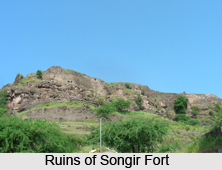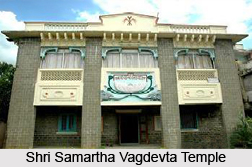 Tourism in Dhule district has a lot for the tourists to discover. The district is strewn with a number of temples, many of them ancient, which are much visited by the pilgrims. There are many temples in the classical Hemadpanthi style here, such as those in Nizampur and Shirud. Apart from the many temples, the district abounds in forts. There are numerous forts that the tourists in the district can visit, such as those at Bhamer and Laling. The Shri Samartha Vagdevta Mandir contains a priceless collection of literary works and manuscripts which are of immense value. People come from near and far, even from outside the country, to see these manuscripts. The various places of tourism in Dhule district are discussed below.
Tourism in Dhule district has a lot for the tourists to discover. The district is strewn with a number of temples, many of them ancient, which are much visited by the pilgrims. There are many temples in the classical Hemadpanthi style here, such as those in Nizampur and Shirud. Apart from the many temples, the district abounds in forts. There are numerous forts that the tourists in the district can visit, such as those at Bhamer and Laling. The Shri Samartha Vagdevta Mandir contains a priceless collection of literary works and manuscripts which are of immense value. People come from near and far, even from outside the country, to see these manuscripts. The various places of tourism in Dhule district are discussed below.
There are a number of beautiful temples located in the district of Dhule. These include the temple at Amali dedicated to Lord Vishnu, the Gangeshvar temple at Chikse, the ancient temple at Indave, the Kapileshwar temple at Mudavad near the confluence of the Tapi and Panjhara built by Ahilyabai Holkar, the Nagai temple on the left bank of the Panjhara river in Nagpur Kokale, the Hemadpanthi temples at Nizampur and Shirud and the ancient temple at Patana believed to have been built in samvat 1884. In Shindkheda Taluka, Methi is known for a group of temples built during the times of the Yadava Kings. Of this group the ones dedicated to Balaji and Bhavani are the most important. Bodgaon was formerly known as Bhojpur after the king Bhoj, who is supposed to have ruled this region. It is known for several old and in some cased dilapidated temples mostly situated on the bank of the Utavalinala. There are four temples dedicated to Mahadev, one each to Maruti- Ganapati and Bhavani and a twelve pillared Samadhi of a unknown saint popularly known as `Bara Khambi Mandir`.
 Apart from the many places of religious significance located in the district of Dhule, there are also available here a number of places of leisure tourism for the tourists. These are mainly in the form of the many forts located here.
Apart from the many places of religious significance located in the district of Dhule, there are also available here a number of places of leisure tourism for the tourists. These are mainly in the form of the many forts located here.
Bhamer
It is known for its fort and more so for the caves or rather monks dwelling that are in the escarpments of the hills above the village. A remarkable features of the fort is that its building is mostly underground, the escarpment being honey-combed with caves. Some of them are plain and shapeless, but others are regular buildings with pillar-supported roots. There caves are locally known as Gavali Raja`s house.
Laling
Located in the Dhulia Taluka, this place is known for an old and ruined fort occupying the top of the hill. It is a place of considerable antiquity and the fort is supposed to have been built during the reign of Malik Raja Faruqui, which was subsequently granted to his eldest son. It was in this fort that Nasir Khan and his son Miran Adil Khan were besieged in 1437 by the Bhanrnani general till they were relieved by an army advancing from Gujarah. Laling has also two Hemadpanti temples in a decayed condition and a ruined Hemadpanti well.
Songir
 It is known for its antique fort. It was previously the chief town of Songir Sub division which was subsequently abolished and Songir was incorporated in Dhule Taluka in 1820. The historic fort has easy access and is entered through a stone gate still in good order. An inscription on this gate dated `Shake` 1497 (1575 A.D.) states that `Ugrasen, son of Mansingh was very brave`. Inside the fort there is a handsome old reservoir and a fine old well. Remnants of broken pipes of the old water systems that must have existed on the fort in the olden days can still be seen. Thalner, the former capital of Khandesh, is also known for its fort.
It is known for its antique fort. It was previously the chief town of Songir Sub division which was subsequently abolished and Songir was incorporated in Dhule Taluka in 1820. The historic fort has easy access and is entered through a stone gate still in good order. An inscription on this gate dated `Shake` 1497 (1575 A.D.) states that `Ugrasen, son of Mansingh was very brave`. Inside the fort there is a handsome old reservoir and a fine old well. Remnants of broken pipes of the old water systems that must have existed on the fort in the olden days can still be seen. Thalner, the former capital of Khandesh, is also known for its fort.
Shri Samartha Vagdevta Mandir
Shri Samartha Vagdevta temple is an invaluable and priceless treasure house of manuscripts, letters and chronicles of historical importance. It is one of the branches of the mother institute Satkaryottejak Sabha established in 1935. The founder of this institute, the late Shri Nana-Sheb Deo, then leading legal practitioner of Dhule, began the work of collection, research and publication of the literature of about 300 saints. This is collected, preserved and studied in this institution and hence is a place of worship of the Goddess of Literature - Vagdevta. This treasure of manuscripts contains researched and non-researched articles as well other manuscripts, papers, letters and badas. This collection is seen and used by scholars and people coming in from all over the country as well as abroad. The manuscripts are in different language scripts and on different subjects.



















